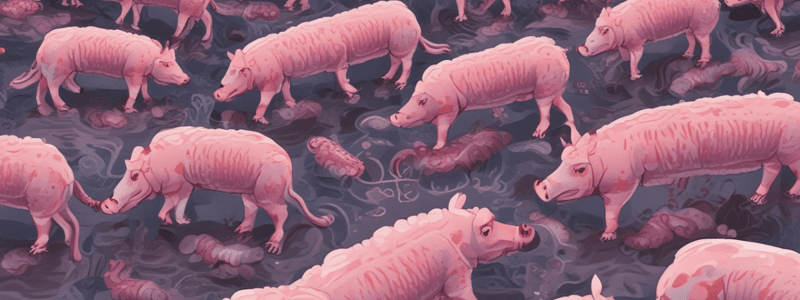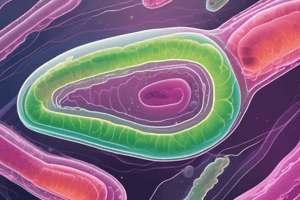Podcast
Questions and Answers
What is the primary mode of adhesion of certain strains of E. coli to absorptive epithelial cells of the jejunum and ileum?
What is the primary mode of adhesion of certain strains of E. coli to absorptive epithelial cells of the jejunum and ileum?
- Through the possession of fimbria or pili (correct)
- Through the release of hemolytic toxins
- Through the production of Shiga toxin 2e
- Through the formation of biofilms
Which of the following Salmonella serovars is most commonly associated with necrotizing enterocolitis in pigs?
Which of the following Salmonella serovars is most commonly associated with necrotizing enterocolitis in pigs?
- Salmonella Choleraesuis (correct)
- Salmonella Dublin
- Salmonella Typhimurium
- Salmonella Enteritidis
What is the primary difference between enterotoxigenic E. coli and hemolytic E. coli?
What is the primary difference between enterotoxigenic E. coli and hemolytic E. coli?
- Enterotoxigenic E. coli produces Shiga toxin, while hemolytic E. coli produces F18 pili
- Enterotoxigenic E. coli causes edema disease, while hemolytic E. coli causes post-weaning colibacillosis
- Enterotoxigenic E. coli produces F18 pili, while hemolytic E. coli produces Shiga toxin (correct)
- Enterotoxigenic E. coli causes post-weaning colibacillosis, while hemolytic E. coli causes edema disease
Which of the following is a characteristic of edema disease caused by hemolytic E. coli?
Which of the following is a characteristic of edema disease caused by hemolytic E. coli?
What is the primary site of colonization by enterotoxigenic E. coli in pigs?
What is the primary site of colonization by enterotoxigenic E. coli in pigs?
Which of the following is a common presentation of Salmonella infection in pigs?
Which of the following is a common presentation of Salmonella infection in pigs?
Which of the following infections results in necrotizing nonsuppurative inflammation of the mucosa and submucosa of the ileum, cecum, and colon?
Which of the following infections results in necrotizing nonsuppurative inflammation of the mucosa and submucosa of the ileum, cecum, and colon?
What is the etiology of Porcine Proliferative Enteritis?
What is the etiology of Porcine Proliferative Enteritis?
Which disease is caused by a coronavirus that infects and destroys villous epithelial cells of the jejunum and ileum?
Which disease is caused by a coronavirus that infects and destroys villous epithelial cells of the jejunum and ileum?
What is the primary mode of transmission of Brachyspira hyodesenteriae?
What is the primary mode of transmission of Brachyspira hyodesenteriae?
Which disease is characterized by hyperplasia and inflammation of the ileum and colon?
Which disease is characterized by hyperplasia and inflammation of the ileum and colon?
What is the primary mechanism of the 'controlled antigen oral exposure' feedback mechanism in Swine Coccidiosis?
What is the primary mechanism of the 'controlled antigen oral exposure' feedback mechanism in Swine Coccidiosis?
Which disease is caused by a coronavirus that affects pigs of all ages and clinically resembles TGE?
Which disease is caused by a coronavirus that affects pigs of all ages and clinically resembles TGE?
What is the primary clinical sign of Porcine Epidemic Diarrhea (PED)?
What is the primary clinical sign of Porcine Epidemic Diarrhea (PED)?
What is the primary cause of Enteric Collibacilosis in nursing and weanling pigs?
What is the primary cause of Enteric Collibacilosis in nursing and weanling pigs?
Which of the following E. coli strains is commonly associated with edema disease in pigs?
Which of the following E. coli strains is commonly associated with edema disease in pigs?
What is the primary site of action of Shiga toxin 2e in edema disease?
What is the primary site of action of Shiga toxin 2e in edema disease?
What is the effect of a high protein diet on the susceptibility of pigs to edema disease?
What is the effect of a high protein diet on the susceptibility of pigs to edema disease?
What is the primary mechanism of action of Shiga toxin 2e?
What is the primary mechanism of action of Shiga toxin 2e?
Which of the following serotypes of E. coli is commonly associated with edema disease?
Which of the following serotypes of E. coli is commonly associated with edema disease?
What is the common name of edema disease?
What is the common name of edema disease?
Which of the following is a characteristic of post-weaning colibacillosis?
Which of the following is a characteristic of post-weaning colibacillosis?
What is the primary age range affected by edema disease?
What is the primary age range affected by edema disease?
What is the primary role of F18 pili in edema disease?
What is the primary role of F18 pili in edema disease?
What is the primary characteristic of the disease caused by Salmonella Choleraesuis kunzendorf?
What is the primary characteristic of the disease caused by Salmonella Choleraesuis kunzendorf?
Which of the following is a common feature of lesions caused by S. Thyphimurium?
Which of the following is a common feature of lesions caused by S. Thyphimurium?
What is the primary characteristic of Type C Enteritis caused by Clostridium Perfringens?
What is the primary characteristic of Type C Enteritis caused by Clostridium Perfringens?
What is the primary lesion of Swine Dysentery?
What is the primary lesion of Swine Dysentery?
What is the primary characteristic of Transmissible Gastroenteritis (TGE)?
What is the primary characteristic of Transmissible Gastroenteritis (TGE)?
What is the primary characteristic of Porcine Epidemic Diarrhea (PED)?
What is the primary characteristic of Porcine Epidemic Diarrhea (PED)?
What is the primary characteristic of Coccidiosis?
What is the primary characteristic of Coccidiosis?
Which of the following is a common feature of lesions caused by Clostridium Perfringens?
Which of the following is a common feature of lesions caused by Clostridium Perfringens?
What is the primary age group affected by Type C Enteritis caused by Clostridium Perfringens?
What is the primary age group affected by Type C Enteritis caused by Clostridium Perfringens?
Which of the following is a common feature of Porcine Proliferative Enteritis?
Which of the following is a common feature of Porcine Proliferative Enteritis?
Flashcards are hidden until you start studying
Study Notes
Enteric Colibacilosis
- Caused by colonization of the small intestine by enterotoxigenic strains of Escherichia coli
- Common in nursing and weanling pigs
- Infection in neonates commonly caused by K88 and 987P strains
- Post-weaning colibacillosis is nearly always due to K88 strain
Edema Disease (E. coli Enterotoxemia)
- Also known as "gut edema" or "bowel edema"
- Caused by hemolytic E. coli that produces F18 pili and Shiga toxin 2e
- Characterized by prominent edema of the submucosa of the stomach and mesocolon
Intestinal Salmonellosis
- Caused by enteropathogenic salmonellae
- Results in inflammation and necrosis of the small and large intestine
- Diarrhea may be accompanied by generalized sepsis
- All ages are susceptible, but most common in weaned and growing-finishing pigs
- Salmonella Choleraesuis kunzendorf (S. choleraesuis) is the most common Salmonella affecting pigs
Clostridium Perfringens
- Type C Enteritis is a highly fatal, necrohemorrhagic enteritis caused by infection of the small intestine
- Lesions include acute, peracute, and necrotic changes in the small intestine
Porcine Proliferative Enteritis
- Also known as Porcine Intestinal Adenomatosis, Proliferative Hemorrhagic Intestinal Enteropathy, and Ileitis
- Common diarrheal disease of growing-finishing and young breeding pigs
- Characterized by hyperplasia and inflammation of the ileum and colon
- Caused by Lawsonia intracellularis
Swine Dysentery
- Caused by Brachyspira hyodesenteriae, B. hampsonii, and B. suanatina
- Transmission is fecal-oral
- Colitis (Porcine Colonic Spirochetosis/PCS) is a disease limited to the large intestine
Transmissible Gastroenteritis (TGE)
- Common viral disease of the small intestine caused by coronavirus
- Results in vomiting and profuse diarrhea in pigs of all ages
- Lesions include severe villous atrophy, malabsorption, osmotic diarrhea, and dehydration
Swine Coccidiosis
- Control measures include increasing farrowing room temperature, minimizing body heat loss, providing electrolyte solution, and vaccination
- Treatment involves no specific treatment, auto-geonus Vaccine, and "controlled antigen oral exposure" (feedback) mechanism
Porcine Epidemic Diarrhea (PED)
- Caused by PEDV of coronaviridae
- Affects pigs of all ages, clinically resembling TGE in several aspects
- Virus spreads by direct contact and infected fomites
- Clinical signs include watery diarrhea, incubation period of 3-4 days, and colic
Enteric Colibacillosis
- Caused by colonization of the small intestine by enterotoxigenic strains of Escherichia coli (ETEC)
- Certain strains of E. coli possess fimbria or pili that allow them to adhere to or colonize absorptive epithelial cells of the jejunum and ileum
- Infection in neonates is commonly caused by K88 and 987P strains
- Post-weaning colibacillosis is nearly always due to K88 strain
Edema Disease (E. coli Enterotoxemia)
- Acute, highly fatal, neurologic disorder usually seen 5 days to 2 weeks after weaning, possibly accompanied by diarrhea
- Caused by hemolytic E. coli that produces F18 pili and Shiga toxin 2e (Stx2e)
- Shiga toxin-producing E. coli implicated in edema disease most commonly belong to four specific serotypes
- Stx2e produced in the intestine of colonized pigs is responsible for the major clinical signs and pathology seen
- High protein diet increases the susceptibility of pigs to the disease
Intestinal Salmonellosis
- Caused by enteropathogenic salmonellae
- Results in inflammation, necrosis of the small and large intestine, and diarrhea that may be accompanied by generalized sepsis
- All ages are susceptible, but most common in weaned and growing-finishing pigs
- Etiology: Salmonella Choleraesuis kunzendorf (S. choleraesuis) and S. Thyphimurium
Clostridium Perfringens
- Type C Enteritis: highly fatal, necrohemorrhagic enteritis caused by infection of the small intestine
- Affects 1-5 days old piglets, but may occur in pigs up to 3 weeks old
- Lesions: acute - small intestine is dark red and hemorrhagic, and contains a hemorrhagic exudate; peracute - gas bubbles in the wall of the jejunum; necrosis of the mucosa of the jejunum and ileum
Porcine Proliferative Enteritis
- Common diarrheal disease of growing-finishing and young breeding pigs
- Characterized by hyperplasia and inflammation of the ileum and colon
- Caused by Lawsonia intracellularis, a gram-negative, small rod-shaped bacterium
Swine Dysentery
- Caused by Brachyspira hyodesenteriae, B. hampsonii, and B. suanatina
- Transmission is fecal-oral
Colitis (Porcine Colonic Spirochetosis/PCS)
- Disease limited to the large intestine that commonly manifests as a mucoid diarrhea in grower-finisher pigs
- Lesions: microscopically, spirochetes may be observed attached end-on to the mucosal surface, giving the appearance of a false brush border
Transmissible Gastroenteritis (TGE)
- Common viral disease of the small intestine
- Causes vomiting and profuse diarrhea in pigs of all ages
- Etiology: coronavirus that infects and destroys villous epithelial cells of the jejunum and ileum, resulting in severe villous atrophy, malabsorption, osmotic diarrhea, and dehydration
Porcine Epidemic Diarrhea (PED)
- Coronavirus diarrhea that affects pigs of all ages
- Clinically resembles TGE in several aspects
- Etiology: PEDV of coronaviridae
- Pigs are the only host known to be infected
- Virus spreads by direct contact and infected fomites
Coccidiosis
- Caused by 8 species of Eimeria, 1 Isospora (suis), and 1 Cryptosporidium (parvum)
- Clinical signs: prevalent in neonates, watery diarrhea, yellowish to white, foul-smelling, weak, and dehydrated
- Lesions: villous atrophy, ulceration, and fibrinonecrotic enteritis
Studying That Suits You
Use AI to generate personalized quizzes and flashcards to suit your learning preferences.




